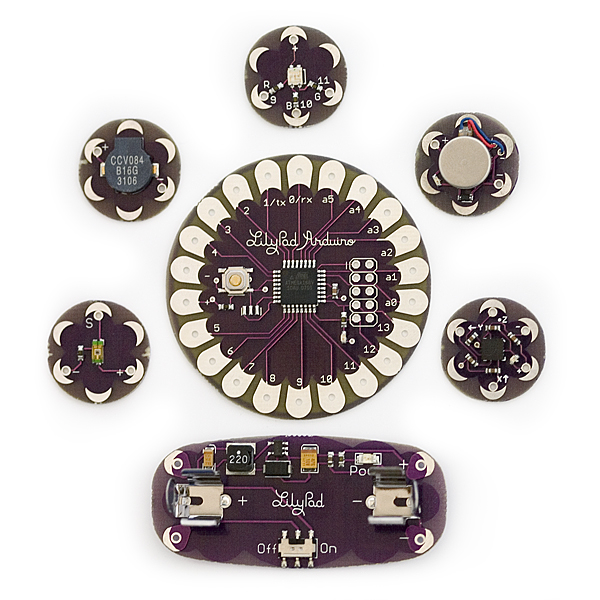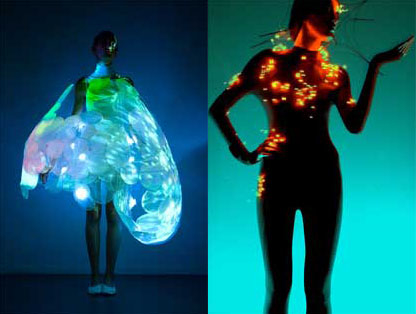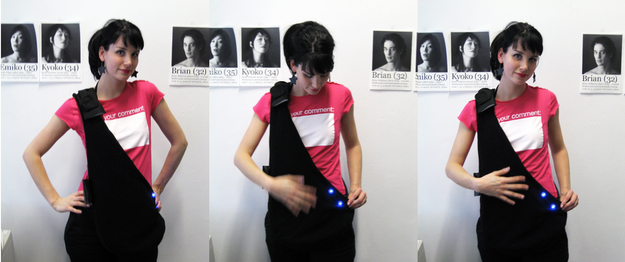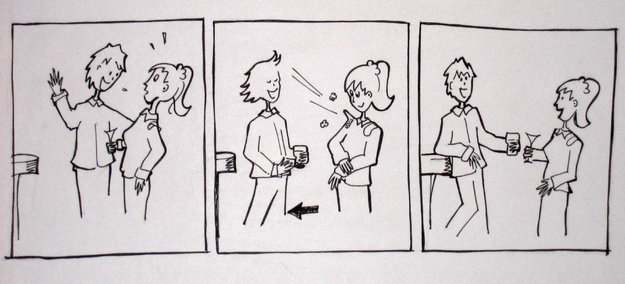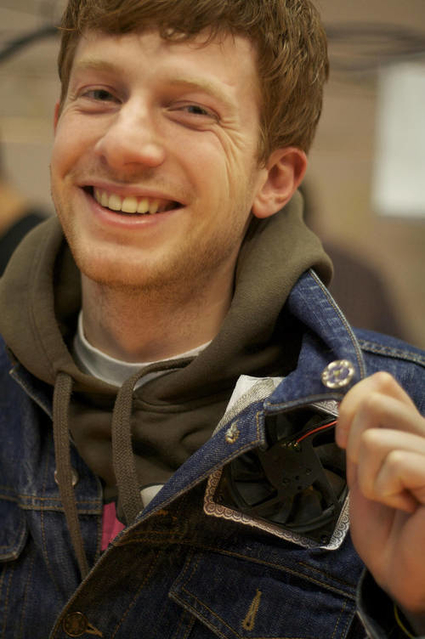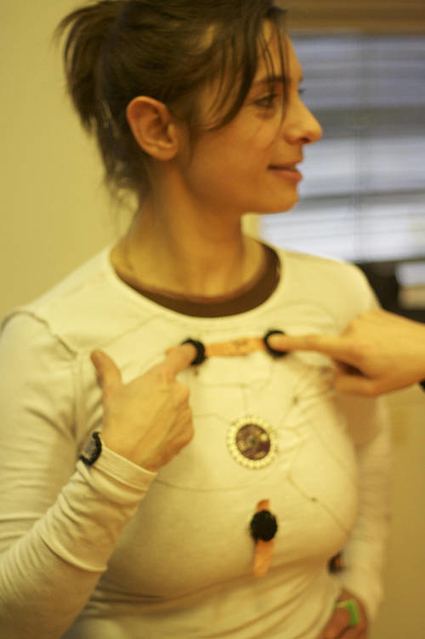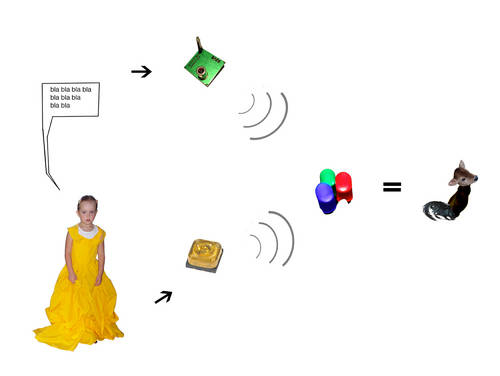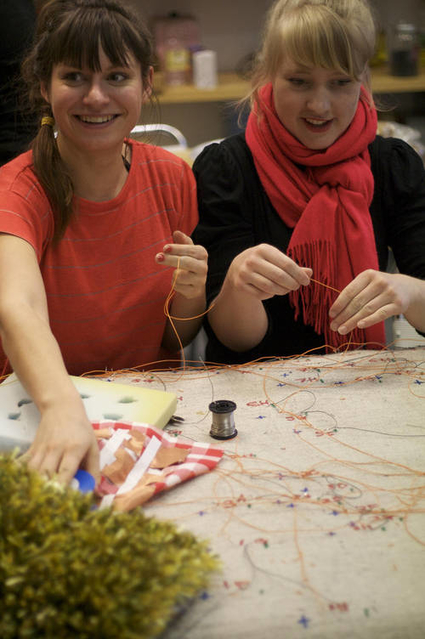Workshop approach
Wearables are about merging what you wear with (communication) technology. They can be thought of as one exponent of the increasingly intimate fusion of digital and physical space.
More and more object are being connected to networks, and become carriers, collectors, and transmitters of various kinds of data. When looking at very personal objects like clothes and jewelry, this development gets particularly interesting.
We're not just talking about pimping your outfit - we're investigating the electronic extrapolation of the role of clothing and fashion. And we're looking at transferring possibilities of other communication devices to clothing, where they may find a more natural home...
In the morning lectures, project presentations and instructions transfer basic knowledge and open new perspectives. Some of the topics that will be investigated in this workshop are: tangible interfaces, clothes as media, social possibilities of RFID technology, new conductive materials, and more.
In the afternoon the participants work on their own workshop projects, assisted by outstanding international lecturers and technical assistants. The workshop closes with a public presentation in which the issues are discussed and some results are shown.
Workshop tools
Specific attention will be paid to the LilyPad Arduino which is an e-textile construction kit designed by Leah Buechley. Besides this we also have Bluetooth- and regular Arduino's available as workshop material, and a collection of sensors and actuators.
As practical research tools the participants can furthermore use various RFID readers and tags and we have a sewing-machine with conductive threads.
Target group
The workshop is designed for a maximum of 16 computer scientists, fashion designers, hardware hackers, art students, fabric experts, product developers or media-makers.
Because of the technical level of this workshop and the limited amount of time (3 days) it is important that the participants have the right skill sets: a basic understanding of electronics and / or relevant experience with design processes. When in doubt please call us!
All participants are assisted personally in realizing their workshop projects. We would advice participants to work in teams of max. 3 people, so you can distribute soldering, coding and sewing tasks.
Trainers & lecturers
Jean-Baptiste Labrune's is a third year Phd student in interaction design in INRIA and University Paris Sud in France. His research group named in|situ| creates new interfaces and interactions for the family.
Dana Gordon graduated from the masters program of Interaction Design Institute Ivrea in the summer of 2006. During the last two years, as part of her Interaction design studies, she focused on physical computing and particularly tangible interface design. She collaborated with companies such as Tecno and Droog Design. Currently based in Paris, she develops new tangible design projects and consults for artistic interactive installations.
Workshop Report
By Nadya Peek
A jacket to solve your social awkwardness, a bag to solve your loneliness.
An overview of the projects from the Hybrid Wearables Workshop
Wearables by Lucy McRae, and other wearable from Lucy in collaboration with Rachel Wingfield.
I do not need my laptop to be merged with my overcoat. I do not want to receive email on a tiny screen mounted on my eyeglasses. I do not have enough attention to distribute to real and virtual life at once. Nevertheless, applications like these are some of the first which come to mind when one mentions wearable computing. Instead, what if your shirt would hug you every now at then? What if your bag would warn you about forgetting your keys? What if your socks explained how to give a fantastic foot massage?
At the Hybrid Wearables Workshop, 16 participants led by Jean-Baptiste Labrune and Dana Gordon played ideas to make our clothes help us more. Not a keyboard for sending email from your pocket, but small solutions for everyday problems.
Wearable project: Cuddle Bag
Are you lonely? Would you like a pet to comfort you, but would you like to avoid becoming a cat lady? Anouk Wipprecht, Nick Lesley, David Morgan and Hans-Gunter Lock made a cuddle bag for you- a functional handbag which doubles as a pet. Stroke it and it will purr, its eyes will light up, and it will warm you.
Wearable project: The ZONE
Do people stand too close to you at parties? Do you feel uncomfortable at social events? Astrid Lubsen, Dick van Dijk, Chris Karthaus and Bertus Rosier made you a jacket that will blow air at your socially inept assailants, subtly hinting that they should take some distance.
The ZONE jacket consists of a light-dependent resistor attached to the collar of the jacket which activates the fan on the wearer's shoulder. The sleeve of the jacket has an interrupt switch, which allows the wearer to switch off the fan in case someone is leaning in the wearer actually likes.
Wearable project: e-Pressed
When we feel stressed, sad or moody, acupuncture could help us lighten up. However, only a select group of experts know which pressure points go with which mood. Barbara Pais, Danielle Roberts, Anja Hertenberger and Helena Kagebrand have made a shirt to solve this problem. The shirt first determines the mood of the wearer. Subsequently, the shirt lights up the pressure points which need to be pressed to sooth the wearer. Anyone can simply press the blinking lights and help the wearer relax.
The cuddle bag has been implemented using soft fabric switches which activate the LED eyes, motors which emulate purring and sounds from encapsulated piezo speakers.
The e-Pressed shirt has a series of switches which have embedded LEDS which light up when those pressure points need to be pressed. In the sleeve, the wearer can indicate which mood he is in by means of a hairpin. Later, the shirt should sense the wearer's mood automatically.
Wearable project: Tæppedyr (carpet animals)
Children's day care centers are often too noisy. According to the Danish government, it is more healthy for children to be in rooms with noise levels below 35 dB. However, which child is going to pay attention to a decibel meter stuck somewhere in the corner of the room?
Barbara Amalie Skovmand Thomsen and Louise Springborg have developed a carpet which reacts to both the presence of a child and the levels of ambient noise. When the noise levels are ok, the carpet lights up with little animals/ghosts around the child. Once it becomes too noisy though, the animals disappear. If there are no animals, the child knows the room is too noisy.
Under the carpet are large soft foam switches which measure the weight on the carpet. Embedded in the carpet are many small leds which animate the animals and ghosts.
Project Prototypes and Arduino code
Below an overview of the project prototypes that were developed during the intense hands-on three day workshop and their Arduino codes.
Cuddle Bag
a bag which inherit the behavior of a cat. It can becomes alive at certain situations. The catting bag needs your attention, and when is being petted, it would open its eyes, purr and warm you.
Tæppedyr (carpet animals)
A carpet merged with a light display as a play ground for children. when children are playing on it, monsters will appear on it. However, when there-s too much noise in that space the monsters will run a way.
e-Pressed
A garment which propose through light display the acupuncture points to be pressed according to current state of the wearer that invites people to press the shirt.
The ZONE
A jacket that protect the wearer's personal space in those awkward public situations. As someone approaches too closely- a fan integrated will blow air at him/her from the jacket.
